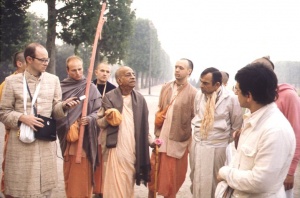CC Antya 1.136 (1975): Difference between revisions
(Vanibot #0027: CCMirror - Mirror CC's 1996 edition to form a basis for 1975) |
(Vanibot #0020: VersionCompareLinker - added a link to the Version Compare feature) |
||
| Line 2: | Line 2: | ||
<div style="float:left">'''[[Sri Caitanya-caritamrta (1975)|Śrī Caitanya-caritāmṛta (1975)]] - [[CC Antya (1975)|Antya-līlā]] - [[CC Antya 1 (1975)|Chapter 1: Śrīla Rūpa Gosvāmī's Second Meeting With the Lord]]'''</div> | <div style="float:left">'''[[Sri Caitanya-caritamrta (1975)|Śrī Caitanya-caritāmṛta (1975)]] - [[CC Antya (1975)|Antya-līlā]] - [[CC Antya 1 (1975)|Chapter 1: Śrīla Rūpa Gosvāmī's Second Meeting With the Lord]]'''</div> | ||
<div style="float:right">[[File:Go-previous.png|link=CC Antya 1.135 (1975)|Antya-līlā 1.135]] '''[[CC Antya 1.135 (1975)|Antya-līlā 1.135]] - [[CC Antya 1.137 (1975)|Antya-līlā 1.137]]''' [[File:Go-next.png|link=CC Antya 1.137 (1975)|Antya-līlā 1.137]]</div> | <div style="float:right">[[File:Go-previous.png|link=CC Antya 1.135 (1975)|Antya-līlā 1.135]] '''[[CC Antya 1.135 (1975)|Antya-līlā 1.135]] - [[CC Antya 1.137 (1975)|Antya-līlā 1.137]]''' [[File:Go-next.png|link=CC Antya 1.137 (1975)|Antya-līlā 1.137]]</div> | ||
{{CompareVersions|CC|Antya 1.136|CC 1975|CC 1996}} | |||
{{RandomImage}} | {{RandomImage}} | ||
==== TEXT 136 ==== | ==== TEXT 136 ==== | ||
<div class="verse"> | <div class="verse"> | ||
:so | :so 'yaṁ vasanta-samayaḥ samiyāya yasmin | ||
:pūrṇaṁ tam īśvaram upoḍha-navānurāgam | :pūrṇaṁ tam īśvaram upoḍha-navānurāgam | ||
:gūḍha-grahā rucirayā saha rādhayāsau | :gūḍha-grahā rucirayā saha rādhayāsau | ||
| Line 27: | Line 26: | ||
<div class="translation"> | <div class="translation"> | ||
'Springtime had arrived, and the fuIl moon of that season inspired the Supreme Personality of Godhead, who is complete in everything, with new attraction to meet the beautiful Śrīmatī Rādhārāṇī at night to increase the beauty of Their pastimes.' " | |||
</div> | </div> | ||
| Line 34: | Line 33: | ||
<div class="purport"> | <div class="purport"> | ||
Śrīla Bhaktivinoda Ṭhākura interprets this verse (Vidagdha-mādhava 1.10) in two ways, for Lord Kṛṣṇa and for Śrīmatī Rādhārāṇī. When interpreted for Kṛṣṇa, the night is understood to have been a dark | Śrīla Bhaktivinoda Ṭhākura interprets this verse (Vidagdha-mādhava 1.10) in two ways, for Lord Kṛṣṇa and for Śrīmatī Rādhārāṇī. When interpreted for Kṛṣṇa, the night is understood to have been a dark moon night, and when interpreted for Śrīmatī Rādhārāṇī, it is considered to have been a full moon night. | ||
</div> | </div> | ||
Latest revision as of 20:07, 26 January 2020

A.C. Bhaktivedanta Swami Prabhupada
TEXT 136
- so 'yaṁ vasanta-samayaḥ samiyāya yasmin
- pūrṇaṁ tam īśvaram upoḍha-navānurāgam
- gūḍha-grahā rucirayā saha rādhayāsau
- raṅgāya saṅgamayitā niśi paurṇamāsī
SYNONYMS
saḥ—that; ayam—this; vasanta-samayaḥ—springtime; samiyāya—had arrived; yasmin—in which; pūrṇam—the complete; tam—Him; īśvaram—the Supreme Personality of Godhead; upoḍha—obtained; nava-anurāgam—new attachment; gūḍha-grahā—which covered the stars; rucirayā—very beautiful; saha—with; rādhayā—Śrīmatī Rādhārāṇī; asau—that full-moon night; raṅgāya—for increasing the beauty; saṅgamayitā—caused to meet; niśi—at night; paurṇamāsī—the full-moon night.
TRANSLATION
'Springtime had arrived, and the fuIl moon of that season inspired the Supreme Personality of Godhead, who is complete in everything, with new attraction to meet the beautiful Śrīmatī Rādhārāṇī at night to increase the beauty of Their pastimes.' "
PURPORT
Śrīla Bhaktivinoda Ṭhākura interprets this verse (Vidagdha-mādhava 1.10) in two ways, for Lord Kṛṣṇa and for Śrīmatī Rādhārāṇī. When interpreted for Kṛṣṇa, the night is understood to have been a dark moon night, and when interpreted for Śrīmatī Rādhārāṇī, it is considered to have been a full moon night.